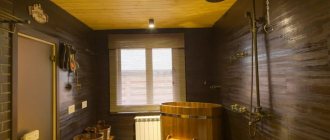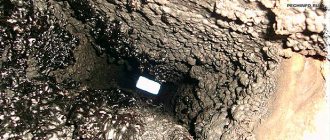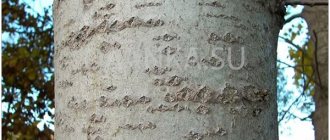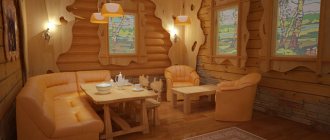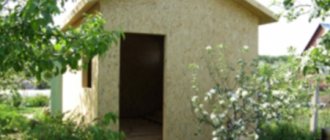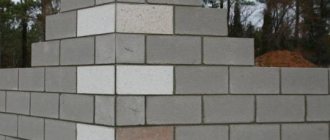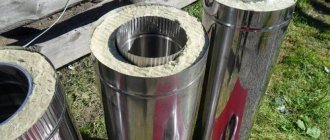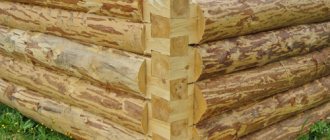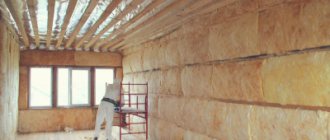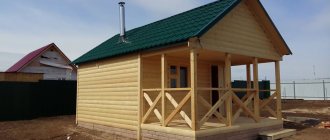25.02.2020
Asbestos board is an insulating material with good fire-resistant characteristics made from chrysotile asbestos fibers. Asbestos cardboard is mainly used for thermal insulation and cladding. The resistance of the material to temperatures up to +500°C is due to its use in places exposed to open flames. The special structure of asbestos cardboard, which can be purchased at any hardware store, determines its durability, since it is not subject to aging.
What is asbestos?
Asbestos is a mineral substance belonging to the category of fine-fiber silicates. There are many deposits of it found in nature. In its natural form, it is a mineral compound that has a spatial structure in the form of the finest flexible fibers. There are two options in terms of structure:
- amphibole-asbestos – has a structure in the form of straight needle-shaped fibers;
- chrysotile asbestos, or white asbestos, has a structure in the form of serpentines, that is, complexly curved or twisted fibers.
Amphibole, in turn, is divided into two subgroups - crocidolites (blue asbestos) and amosites (brown asbestos).
Brittle amphibole asbestos is considered more dangerous: small and sharp particles inhaled by humans when the fibers break down are harmful to health. Once in the body, harmful dust does not dissolve and is not removed from the lungs - it remains there for life, gradually growing into the tissues and poisoning the owner.
Serpentines have a softer structure and are therefore considered less dangerous. They, unlike amphibole, quickly dissolve and are eliminated from the body without causing much harm.
Varieties
There are these types of mold:
- Black. There are many mold strains. It is impossible to distinguish the culture of the virus without testing. You can tell that a bathhouse is affected by a black infection by the rapid spread of mold, destruction of the affected areas, and rotting of the material. It is considered the most dangerous for humans. Spores, penetrating into the body, cause poisoning and act as a provocateur of serious pathologies. A negative property of black mold is its high resistance to antifungal agents.
- White. Does not tolerate aggressive environments well. Formed on wooden boards, products, and food products. They are dangerous for humans due to the development of an allergic reaction.
- Blue fungus. It destroys wood materials and activates the process of decay. It creates a great danger for load-bearing structures. The more the rotting process has spread, the lower the ability to withstand heavy loads. The rigidity of the structure is lost. There is a possibility of roof collapse.
- Actinomycete. Outwardly it resembles white algae, similar to mold fungi. Appears in ultra-humid microclimates. Fungus on the walls of the bathhouse, ceiling or floor, living for a long time, softens the structure of the wood.
Where was asbestos used?
During its heyday, this mineral substance was widely used in various types of production, in the automotive industry, shipbuilding, aircraft construction and, of course, in construction. To this day, we can find this substance in old residential buildings, where it was used in pipe insulation elements, ceiling and floor coverings, paints and finishing materials, as a cement additive and in the manufacture of roofing slates. This material was actively used in the construction of bathhouses on personal plots. Summer residents did not suspect that when asbestos is heated, the harm to health increases several times.
It was used in the production of consumer goods - heaters, household utensils, cosmetics, and even in the manufacture of children's crayons. At that time, it never occurred to anyone how dangerous small particles of asbestos could be.
The health damage resulting from exposure to this mineral was felt primarily by those people who participated in the production process.
What affects the cost of basalt cardboard
The cost of the material depends on many factors. First of all, this is the presence of foil. Foil basalt cardboard will cost the buyer 20-25% more than usual.
The size of the sheets also affects the price of insulation. The greatest demand is for sheets of size 1200x600x10. A sheet of 1000x600x10 will cost a little less. There is also cardboard 6 mm thick. The cost of such material in a foil version ranges from 170 to 220 rubles, in a regular version from 150 to 190 rubles.
The next criterion that influences the price is the thickness of the basalt fiber used for the production of cardboard. There are two types of fibers: superfine and medium fibers.
Mats made from thin and superfine fibers are more expensive, but melt faster at temperatures of 7000C or more. If the material will operate at extreme temperatures, it is better to use medium-fiber cardboard.
As with the purchase of any other product, when purchasing in bulk, the price of basalt cardboard can be significantly reduced due to discounts, promotions, bonuses, etc. It should also be taken into account that products from well-known brands, even with the same quality, will cost more than products from little-known manufacturers.
First information about the dangers of the mineral
The first information about the dangers of asbestos to health began to arrive after examination of employees of mining mines, who also used this material in their work. Many workers were diagnosed with various pathologies, signs of cancer, and especially often there were disturbances in the functioning of the bronchopulmonary system.
After numerous studies, the International Agency for Research on Cancer published the result in 1987: asbestos is harmful to health. Lung cancer, mesothelioma, various fibrosis, asbestosis of varying severity and other types of cancer tumors appear in the human body precisely due to exposure to amphibole.
Use in household equipment
Basalt cardboard, the use of which is also advisable for insulating various types of heating and cooling structures from the temperature effects of the environment, is gradually displacing such a common, once environmentally unsafe material as asbestos sheets from the market.
Without losing its qualities, cardboard can withstand enormous temperatures. Very often it is used, for example, for lining pipes and chimneys. Cardboard is also used to create heat-resistant substrates between floors, walls, ceilings and stoves. In heating domestic and industrial boilers, it is used to wrap heating elements.
Another area of application for these dense fibrous sheets is the thermal insulation of refrigerators, stoves and ovens. Basalt cardboard is also used for wrapping water pipes, as well as air ducts of supply ventilation systems.
Where else is asbestos found?
This mineral is still present in outdated car models, some residential buildings, and old country houses. For many summer residents, asbestos in the bathhouse is a source of particular harm to health. After all, back in Soviet times it was used as a fire-resistant material for various coatings.
Asbestos does not burn, but when exposed to high temperatures it begins to break down, releasing harmful amphibole. Not all owners of country cottages are aware that they are exposing themselves and their household members to mortal danger.
The danger of chrysotile asbestos - myth or reality?
In Ukraine they want to introduce a ban on chrysotile asbestos. They even give a reason - supposedly asbestos causes cancer.
And, quite naturally, the main questions that concern the consumer are:
- Is it possible to use chrysotile containing materials in construction?
- If you buy such material, will it be safe?
- What to do with chrysotile cement sheets, slates and pipes that have faithfully served their owners for many years?
- Is it really necessary to get rid of them and look for an alternative?
To understand whether it is safe to use chrysotile asbestos in construction, you need to study detailed information about it.
Scope of application today
In Russia, despite the undoubted harm to health, asbestos is contained in more than 3,000 different products: it is used for the production of filters and tarpaulins, paper and cardboard, protective suits for firefighters and some asbestos-cement building materials. In our country, it is allowed to be used in many industrial technologies, but its use must be strictly controlled.
By the way, it’s worth making a reservation here. It is not the asbestos products themselves that are harmful to the human body, but the small particles of this mineral suspended in the air. Typically, the suspended state of fine asbestos dust can only be observed during mining, in some technological processes of various industries, or during the destruction of old buildings. To obtain harmful particles in domestic conditions, you will need to purposefully crush an asbestos-containing product (the same slate).
However, any product begins to deteriorate over time. As a result of aging, mineral fibers break down into fine dust, which can become an allergen for the human body. Once in the lungs, harmful asbestos remains there forever. When it grows into tissue, it causes enormous harm to health. Although the first signs of illness may appear only after a few years. It is known that in people who came into contact with such dust, various oncological formations appeared on average only after 7 years; in many patients it took even longer.
Is asbestos harmful to health? 6 facts
Is asbestos or asbestos dust harmful to health? This topic has been exciting the minds of ordinary citizens for decades. Should the roof of a country house be covered if it is covered with slate and some of the world and Russian facts.
This material brings together reviews backed by years of research and hard facts regarding slate and asbestos.
Are there toxic building materials and is asbestos-cement slate one of them?
There is no official list of toxic building materials in the Russian Federation. Nevertheless, the building materials market is under control, and a prerequisite for a particular product to hit the shelf is the presence of a hygienic certificate of product conformity. This document is issued by Rospotrebnadzor services after checking the compliance of products with established hygienic standards and regulatory and technical documentation approved by Rosstandart. Thus, at least two government agencies monitor the safety of building materials.
If we talk about international experience, the use of hazardous chemicals and pesticides is regulated by a special international agreement - the Rotterdam Convention. But even in this document, chrysotile asbestos (this is the form of the mineral used today in industry and production) is not subject to a ban and is not called toxic.
Is asbestos harmful to health?
This paragraph should begin with the fact that asbestos is different from asbestos. In many ways, it was the differences in the physical and chemical properties of different forms of the mineral that became the basis for whipping up unfounded fears among the population.
- Thus, chrysotile (white) asbestos does not pose a health threat when used in a controlled manner. Even if it enters the body, its fibers dissolve and are excreted within a few days.
- But amphibole (blue) asbestos is resistant to acidic environments and has a long fiber length. Once in the lungs, its particles remain in the body for a long time and can cause diseases.
However, in Russia and the CIS countries, amphibole asbestos has never been used for civilian purposes. So even the old slate that may cover your country house does not pose a threat.
An international group of biological researchers from Switzerland, Great Britain, Germany and the USA in 1999–2010 studied the duration of elimination of various fibers from the body. According to the research results, the period of dissolution and removal of chrysotile asbestos fibers was 0.3–11 days.
Russian-made slate is resistant to alkaline environments, but decomposes in acids with the formation of amorphous silica. This is what distinguishes it from prohibited asbestos.
Asbestos is used in Russia for production
- paper, cardboard,
- filters,
- tarpaulin,
- fire-resistant fabrics from which suits for firefighters are sewn,
- asbestos cement pipes,
- asbestos-cement corrugated and flat sheets,
- asbestos cords and sheets, much more.
Due to their fire-resistant properties, asbestos boards and cords are very popularly used in bathhouses: they are used to isolate fire points in wooden structures (the floor near the stove, metal pipes passing through the ceiling). Flat slate can be used to cover wooden walls where a metal sauna stove is installed. All these measures prevent fires in the bathhouse from heating and smoldering wood from high temperatures.
Is asbestos dust hazardous to health?
Inflammatory processes in the human body can be triggered by any dust (cement, flour, wood, textile, cellulose, glass dust) if its concentration exceeds the maximum permissible values (MPC). With constant contact with high concentrations of dust, the body’s mucous membranes cannot cope with the task of retaining and removing foreign elements. Dust particles accumulate and can cause disease. But with controlled use, such a situation is difficult to imagine.
However, do not forget that minimal respiratory protection must be used during any construction and repair work. By protecting yourself from all types of dust, you guarantee yourself good health.
What does the formula “controlled use” mean?
Scientists and doctors from Russia and other countries agree: chrysotile asbestos is safe when used in a controlled manner. But what does this formulation mean? Can consumers and manufacturers of products containing chrysotile asbestos be confident about their health?
In accordance with Convention No. 162 “On Occupational Safety and Health in the Use of Asbestos” of the International Labor Organization (ILO), which has been ratified by 35 countries, including Russia, compliance with the recommendations set out in it with the implementation of a set of organizational and technical measures to control the use of chrysotile asbestos and products based on it guarantee the safety of its use for people and the environment.
Also, the wording “controlled use” also applies to end consumers. Of course, you should apply the simplest safety measures when repairing and disposing of chrysotile asbestos products and protect your respiratory system with a respirator. This measure is necessary not because of the presence of chrysotile in the material, but because of the possible formation of dust, including that containing cement.
Products made from chrysotile cement are approved for use in construction in the Russian Federation in accordance with hygienic standards GN 2.1.2/2.2.1.1009-00, approved by the Chief Sanitary Doctor of Russia.
Numerous studies (for example, conducted in 2020 by the Atmosphere Research Institute, St. Petersburg, etc.) give a clear answer that chrysotile fibers are not released from slate either during operation or even at the recycling stage (the usual service life of slate is about 50 years old).
Why does asbestos cause so much controversy?
In the post-war years, the production of amphibole asbestos grew rapidly in the USA and Western Europe. At some point, uncontrolled interaction with the dusty substance accumulating in the body became the subject of public discussion. Amphibole asbestos was banned, and the market was filled with manufacturers of synthetic analogues of the mineral.
It so happened that the interests of a whole range of groups intertwined around asbestos, each of which pursues its own goals. Manufacturers of competing building materials were interested in eliminating chrysotile cement products (affordable and durable) from the market; law firms found a goldmine by suing large companies for compensation for the allegedly damaged health of workers; construction firms have made fortunes by substituting and recycling supposedly hazardous building materials; doctors and officials wrote out the “necessary” conclusions and received a good income for this.
Asbestos is banned in Western Europe. Why isn't Russia following suit?
Some Western European countries have actually banned all forms of asbestos. In many ways, these restrictions are associated with an attempt to protect their own producers of alternative building materials, but mainly with a complete disregard for the simplest safety measures in the first half of the 20th century.
The United States is a good example of practicality. Despite the heat of passion, the use of chrysotile asbestos is permitted in this country. Moreover, American companies purchase part of the chrysotile fiber from Russia.
It is also worth noting that countries where two-thirds of our planet’s population live continue to use asbestos effectively. These include India, China, the USA, Russia, Kazakhstan, Uzbekistan, Indonesia and more than 100 different countries.
Today, people use a huge amount of natural and artificial fibers, many of which can pose a danger to human health. And a competent, civilized approach to their use lies precisely in compliance with long-standing and well-known measures to prevent air pollution by dust particles, and not in groundless calls for a ban on their use.
Causes of the disease
It is still not clear how exactly asbestos dust causes lung diseases. Most likely, the development of pathologies occurs due to injury to the mucous membranes, which causes hyperplasia, metaplasia and proliferation of the epithelium. Manifestations of metaplasia are associated with the chemical composition of certain types of mineral containing kieselguhr. There are opinions that the occurrence of oncological diseases of the bronchopulmonary system is promoted not by the chemical properties of asbestos, but by severe bronchiectasis changes that occur as a result of constant inhalation of dust.
However, in any case, the disease is based on inflammatory processes of the respiratory tract in the form of chronic nasopharyngitis and bronchiolitis, caused by mechanical and chemical exposure to asbestos dust.
Take care of yourself and your loved ones! Do not be exposed to harmful dust!
If you are planning to build a bathhouse, then during construction you are probably planning to use the material that we will talk about in our article. However, during installation the question may arise as to whether asbestos is harmful to health when heated. Let's talk about this, the properties of the construction product and its analogues.
How to insulate a stove from a wooden wall
The ideal design has the following structure:
- Wall;
- The ventilation gap is 2-3 cm;
- Insulation 1-2 cm;
- Stainless steel sheet.
Remember that the total distance from the wall to the stove must be more than 38 cm. For fastening, use ceramic bushings that will help form ventilation gaps. If the distance between the wall and the stove is minimal, then it is necessary to use two layers of mineralite slabs, between which a gap must also be left.
What is asbestos
This building material consists of fine-fibered minerals. It tolerates high temperatures well, withstands fire, and is very strong and elastic. Now in construction stores and markets you can find both individual sheets and see this substance as part of cement mixtures and other building materials.
Properties of asbestos
It has found wide application in the construction industry due to its special properties:
- Low electrical conductivity
- Heat resistance
- Resistance to radiation exposure
- Gas absorption capacity
2 types of material
- Chrysotile asbestos is a multilayer silicate that withstands alkali well. It is this substance that can most often be found on the Russian market.
- Amphibole - despite similar physical properties to the previous type, it has its own structure. It is not used as often as the first one, since it is significantly inferior in quality. In addition, many countries have banned its use because it emits substances hazardous to health.
They also differ in color, composition and length of the fibrous component, which subsequently affects wear resistance and durability.
Famous manufacturers
Currently, several well-known companies occupy leading positions in the field of basalt cardboard. The products of these enterprises have their own distinctive features.
Rocklight
The products of this company are distinguished by stable shape and volume of sheets, low moisture absorption, high sound insulation properties and minimal thermal conductivity. Standard sheet dimensions are 1200x600 mm. The material is easily cut using a hacksaw or cutter, which greatly simplifies the installation process. The cost of a 5.76 m2 package is 870 rubles.
Nazarovo
The materials produced by the company are widely used due to their hygroscopicity and fire resistance. The company's products are used for insulation and sound insulation of building structures for various purposes. Basalt cardboard is environmentally friendly, which is confirmed by relevant certificates. The cost of packing sheets measuring 1200x600 mm is approximately 960 rubles.
Rockwool
The company has long been known in the market as a manufacturer of high-quality basalt insulation materials. Rockwool basalt cardboard is weather-resistant, environmentally friendly, and has high heat and sound insulation. Standard sheet size is 610x1000 mm. A pack of sheets with a total area of 10.45 m2 will cost approximately 1,500 rubles.
Isoterm
The company produces basalt sheets of standard sizes 1200x600 mm. The company's products are characterized by low thermal conductivity, hygroscopicity and good sound insulation. Due to its plasticity, Izoterm basalt cardboard is often used for cladding various curved surfaces, chimneys, air ducts, etc. Cardboard is resistant to moisture and ultraviolet radiation. The average cost of a package is 1450 rubles.
Paroc
Due to their resistance to negative atmospheric influences and the ability to work at variable temperatures, the respans produced by Paroc can be used for both interior and exterior work. The flexibility of the material allows it to be used for insulation of air ducts, chimneys, heating boilers and other building structures. Paroc cardboard has low thermal conductivity and good sound insulation. The price of a sheet 600x1000x30 is on average 450 rubles.
BASWOOL
BASWOOL has focused on achieving the lowest thermal conductivity of basalt cardboard. That is why the company's products are widely used in industrial and civil construction. The hygroscopicity of the material allows it to be used in rooms with high humidity, and its high sound insulation properties increase overall comfort. Standard sheet size is 1200x600x100. The cost of 1 m2 is approximately 800 rubles.
Tizol
Another domestic manufacturer whose products are in high demand among private developers and construction companies. Soft basalt board BVTM-PM and basalt cardboard BVTM-K meet all the requirements of international quality standards and environmental safety. The insulation is available in both foil and simple versions. A high level of heat and sound insulation is provided by MPB mats made from ultra-thin staple fiber BSTV-st, with a thread diameter of no more than 3 microns. The mats are stitched with basalt fiber, which eliminates the use of binding components.
There are other manufacturers of basalt insulation, but their products are less in demand on the building materials market.
Where is it used
If you study the question of what asbestos is needed for, you will notice that it is used in various fields, including industrial production and construction.
Construction
In installation work, its fire resistance and thermal insulation are especially valued. Therefore, very often when installing wall panels or laying floors, asbestos boards or wool made from the same substance are used.
Mechanical engineering and metallurgy
Cables and various metal and concrete structures are usually treated with this mineral in the form of spraying. This is how they acquire fire-resistant properties.
In addition, in some houses, cement pipes with the addition of this substance are installed. It is thanks to him that they become stronger and more durable.
Chemical industry
Asbestos has also found application in the chemical field, where it is used to make various plastics, paper and paint and varnish products.
Textile industry
Here this mineral is used in the manufacture of fabrics for workwear. It is used to make protective gloves, helmets and suits. In addition, brake flanges and pipe seals are also made with its addition.
Metal protective screens
On the construction market, the most common metal protective screens are made of steel or cast iron. Many manufacturers of iron furnaces provide thermal insulation for their products, providing them with special casings.
Choosing protective screens is quite simple, because depending on the side of the furnace to be insulated, you can purchase a front or side panel. Installing such screens will also not cause difficulties, because the manufacturer provides special legs that can be easily attached to the floor.
Next we should talk about the installation rules. The panels themselves are installed at a distance of 1-5 cm from the stove, but a distance to the adjacent wall is also required. Protective screens reduce the radiated temperature to 80-100°C, which allows them to be installed 50 cm from a parallel wall.
Is it harmful to health?
There is a popular belief that building materials are extremely dangerous to human health due to harmful fumes. There is another version that speaks of its safety, which has not yet been definitely confirmed. Let's look at why asbestos is dangerous.
Indeed, prolonged contact with the material during installation can have a detrimental effect on the body. For example, occupational diseases associated with this fibrous substance include chronic respiratory diseases, fibrosis and even lung cancer.
The occurrence of these diseases is due to the fact that when inhaling dust particles from asbestos, its fibers are not removed from the lungs, but settle there for life. Thus, they gradually destroy the organ and harm health. However, you can only get sick if a person stays in a place with such dust for a very long time.
The substance only when combined with cement does not emit any harmful fumes and is completely safe for humans. But it is still better to refrain from using it in a bathhouse, since with periodic heating it can crumble over time. And this will lead to the spread of dangerous dust in the air.
Localization
The bathhouse consists of several compartments, some of which are highly susceptible to mold:
- Steam compartment. There is often no window or ventilation. The room dimensions are small, the temperature and humidity are high.
- Waiting room. Damp, warm room. Microclimate conditions are favorable for breeding large-scale colonies of molds.
- Shower room. A small room without windows. There is constant humidity around the pan, in places where water drains.
- The inner surface of the walls where the bath broom is hung. A damp object in an unventilated room takes a long time to dry, and dampness between the product and the side of the room remains for a considerable time.
- Joint of logs. If the bathhouse is built of timber, moisture accumulates between the structural elements.
- Bath shelves. Water often remains on the outer surface of products. If the liquid is not removed, a favorable environment is created for fungi.
Sauna owners were a little luckier. Dry air inside the steam compartment and high temperature conditions prevent the spread of mold.
Corner areas of the room are considered the most susceptible places. Even in a well-ventilated room, air flows in poorly. The ceiling often suffers from mold. Due to the accumulation of warm air masses, condensation appears. Moisture accumulates on the inside and drops form. Late detection of mold leads to a large-scale spread of infection to clean areas of the building.
The fungus often takes root on wooden materials and lining. Concrete and brick are less susceptible to mold, but there is a risk. No type of building materials is protected from damage.
How to replace asbestos
Now there is a huge selection of materials that have the same properties and are well suited for replacement.
Insulation in a roll
He makes three types of mineral wool:
- Basalt wool
- Glass wool
- Slag
Each type is suitable for certain types of work. In accordance with the instructions, select exactly the analogue that you need.
This building material is heat resistant and retains heat well.
Foam glass
This material is lightweight, durable, fire resistant and waterproof. It provides not only thermal insulation, but also has the ability to muffle sound.
Fire-resistant drywall (GKLO)
If it is necessary to insulate the wall in the bathhouse, which is located near the stove, you can use gypsum plasterboard. This fire-resistant material can also withstand high temperatures and does not emit harmful substances when heated.
How to attach basalt cardboard
There are several ways to attach basalt cardboard. The choice of one or another technique depends on the specific operating conditions. For interior work, gluing mats using liquid nails or assembly adhesive is quite sufficient. In addition, the sheets can be attached to the walls using a stapler or self-tapping screws.
If foil-coated basalt cardboard is used, the foil should face the inside of the room. The foil will reflect heat back into the room, which will increase the effectiveness of thermal insulation.
During outdoor work, the number of unfavorable factors increases noticeably. In order to ensure reliable fixation of the insulation on the facade of the building, special fasteners are used.
To conclude the article, we present several reviews from builders regarding basalt cardboard published on the Internet.
Is asbestos harmful?
Asbestos dust is a carcinogen
upon contact with the respiratory tract. You can verify SanPiN 1.2.2353-08 “Carcinogenic factors and basic requirements for the prevention of carcinogenic hazards”
Asbestos dust causes great harm. During work, namely drilling, cutting and other activities, it releases a lot of dust, which, when it enters the respiratory tract, settles in them and is not removed by anything. This dust causes lung cancer and there is also a disease called Asbestosis.
The photo shows the consequences of working with Asbestos. High magnification micrograph of pulmonary asbestosis, with characteristic glandular bodies and interstitial fibrosis. Lung biopsy. H&E stain.
Based on the results of comprehensive scientific studies of carcinogens, the International Agency for Research on Cancer has classified asbestos in the first, most dangerous category of the list of carcinogens for which there is reliable evidence of their carcinogenicity to humans.
It can be argued that asbestos itself is not harmful, but its dust is. Those. If you cut it in a respirator and twist it in a bathhouse, and then clean it up, then everything will be fine. Not really! Don't forget that any structure is alive and moves. Especially the bathhouse. It doesn’t matter what material it is made of, there are still small movements during which the asbestos will rub and release dust, and the microclimate of the steam room will do its job to move it in the steam room.
Dust is also treacherous. It does not manifest itself immediately, accumulates for years, and then deals a crushing blow to the body. In Europe, the use of asbestos has been banned since 2005.
What do we get in the end? Using asbestos in the construction of baths, you can collect stones at the mining and processing plant and put them in the heater. It will not be worse.
Friends, we are building a bathhouse to heal the soul and body. Let's not skimp on our health and use environmentally friendly materials. We are already surrounded by harmful substances, let’s not aggravate our situation with our own actions. In addition, there are alternatives in different price segments. Peace and goodness to everyone!
Thermal insulation work
Floor
The base can be insulated even at the stage of construction of the log house
After completing the preparatory work, we proceed directly to thermal insulation. It’s best to start from the bottom of the room, so when I tell you how to insulate a bathhouse from the inside, I will first of all describe the floor insulation technology I use.
The soil base must first be covered with sand, and only then insulated
It is best to start insulation before installing the flooring, in the open underground space:
- We level and compact the soil base, after which we pour at least 20 cm of sand or sand-gravel mixture onto the ground. We carefully compact the pillow until the volume of the bedding stops decreasing.
It is most effective to compact sand using special devices.
- For greater reliability, you can make a footing - pour a screed up to 10 cm thick on top of the sand backfill. It is advisable to use a cement hardener, since otherwise the process will drag on for at least 28 days - this is exactly how much is needed for complete polymerization of the solution.
Scheme of sand filling the floor for insulation with expanded clay
- If the bathhouse is being built on a monolithic foundation or a base made of concrete slabs, then the concrete should be treated with waterproofing impregnation and roofing material should be laid on top. Instead of roofing felt, you can use bitumen mastic.
Waterproofing with bitumen mastic
- We pour expanded clay on top of the concrete base or concrete layer with waterproofing. It is advisable to take expanded clay granules of several different fractions, which will allow them to be laid as tightly as possible. The optimal thickness of the expanded clay layer for thermal insulation is 30 cm or more, so this must be taken into account at the design stage .
Pouring expanded clay with solution
- In order for the expanded clay to lie flat, it should be filled with either cement laitance or a very liquid solution. This solution penetrates into the thickness of the thermal insulation material to a depth of 20–25 cm, fastening the top layer and forming an almost monolithic structure with a large amount of entrained air.
Perlite can also be used for bulk thermal insulation.
If you have a large enough container for mixing the solution, you can make expanded clay concrete by mixing granules with the solution and placing the resulting mass in the space between the floor joists. Instead of expanded clay, you can also use perlite - the resulting perlite concrete also has good thermal insulation characteristics.
- The level of expanded clay backfill depends on the planned floor structure. If we plan to limit ourselves to expanded clay, then the top edge should be approximately 30-40 mm below the top edge of the logs. For comprehensive insulation (expanded clay + slab material), we lower the backfill below.
If expanded clay is poured to the top of the joists, then the subfloor must be raised to form an air gap
- Be sure to lay a vapor barrier on top of the expanded clay - membrane, glassine, foil film, etc. This layer will protect the porous material from condensation moisture, which significantly increases thermal conductivity. The vapor barrier should also cover the wooden joists, leaving only 4-5 cm sections open at their ends for the escape of water vapor from the wood itself.
Laying slab materials on expanded clay on top of a vapor barrier
- If you plan to use slab materials, then lay insulation on top of the vapor barrier - polystyrene foam, polystyrene or mineral wool. We seal the foam and polystyrene with polyurethane foam, blowing out the seams, and cover the mineral wool with another layer of vapor barrier.
It must be borne in mind that polystyrene foam, polystyrene and other synthetic materials are not suitable for steam rooms - under intense temperature loads they release volatile toxins. So in the steam room - only heat-resistant mats (best foil) based on mineral fiber.
Laying the floor over vapor barrier and mineral wool slabs
After forming the thermal insulation layer, we lay the subfloor from boards or moisture-resistant plywood, and then lay the finishing flooring from a tongue-and-groove floorboard or tiling the surface.
Wall and ceiling finishing
Now let's figure out how to properly insulate a bathhouse from the inside, minimizing heat loss through the wall enclosure and ceiling. Again, let's focus on the method of finishing the steam room - in the dressing room, in the relaxation room and other rooms we do the same, but with a decrease in the thickness of the thermal insulation layer.
Lathing for thermal insulation in a wooden frame
The walls and ceiling in a bathhouse are most often insulated using frame technology, and this is the method I use:
- First, I install the sheathing beams onto the base using anchors. The thickness of the beam must correspond to the thickness of the heat-insulating material used, since the insulation should not extend beyond the plane of the frame. If you plan to use 75-100 mm mats, then you can take not a square, but a rectangular beam, placing it on its edge, or place support blocks under the beams, securing them at a distance from the wall.
There should be no gaps between the wall and the insulation, the sheathing and the insulation!
When installing on blocks, it is worth keeping in mind that it is undesirable to leave empty spaces between the wall and the beam. Therefore, before installing the main part of the thermal insulation material, these gaps should either be blown out with foam or filled with scraps of mineral wool.
- The lathing configuration is determined by two factors. I choose the pitch depending on the width of the insulating panel (most often it is 60 cm), and the direction depending on the direction of the sheathing panels. If you plan to install horizontal lining, then I make the sheathing vertical and vice versa.
Vertical lathing on concrete for horizontal installation of lining
- Under the sheathing beams or through them I run a cable duct with wiring for lighting and ventilation (if a forced exhaust fan is installed). As a cable channel I use either a pipe or a fire-resistant metal casing. When laying, I try to minimize the number of through holes in the sheathing bars.
Laying mineral wool between the sheathing beams
- Now I am installing thermal insulation boards. If the pitch was initially chosen correctly, then the panels based on mineral fiber fit between the beams with little effort and are fixed there by surprise. To make my life easier, I make lathing on the ceiling with a pitch of 57-58 mm: yes, the slab shrinks a little and loses heat transfer resistance, but it doesn’t fall out .
Glassine vapor barrier
- I make sure to lay a vapor barrier layer on top of the insulation. Polyethylene film will not work here because it will not withstand constant heating to high temperatures. Previously, almost everyone used glassine, but today it is much better to take Alubar, Penofol or any other foil material.
Foil vapor barrier on the frame. The photo clearly shows the gap between the insulation layer and the sheathing
- I lay the foil covering over the entire area of the walls and ceiling, attaching it to the sheathing with staples using a construction stapler. I make the joints of the canvases with an overlap of at least 100 mm, always gluing them with metallized tape.
- If the outer edge of the insulating panels is flush with the edge of the sheathing, I stuff slats about 30 cm thick onto the beams to create an air gap. If the gap is already sufficient (i.e. the thickness of the insulation is less than the depth of the frame), then the counter-lattice need not be installed.
Installation of lining on a horizontal counter-lattice on top of a vapor barrier foil layer
Then we install cladding made of clapboard (in the steam room) or other materials (in the dressing room, etc.) onto the frame. We install skirting boards and ceiling fillets and treat the cladding with protective and decorative impregnations for baths and saunas.
Installation of ceiling cladding
Overlap
If on the room side the ceiling is insulated in the same way as the walls, then on the attic side the top floor is usually thermally insulated using a different method.
The instructions that I use suggest the use of cheap and easily accessible natural materials, while minimizing heat loss:
It is in the space between the beams that the thermal insulation material will be laid
- I lay two layers of fiberglass on the ceiling between the ceiling beams. You can also use a vapor barrier membrane, but then we will block the exit of condensation moisture from the ceiling insulation - and this will have to be compensated for by more intense internal ventilation.
- Then I prepare a thermal insulation solution: I mix dry clay with water and add sawdust. The ratio with clay is approximately 1: 1. The consistency of the solution is from thick sour cream to batter: the composition should spread, but rather slowly .
You can add chopped straw, chaff and other materials.
Preparing a mixture of clay and sawdust
- I pour the solution into the gap between the ceiling beams, trying to minimize the number of voids. I level the surface of the solution and allow time to dry.
- After this, I either cover the clay with a vapor barrier film or lay a layer of polystyrene foam boards.
Ceiling insulated with clay
- On top I install a flooring made of boards or plywood: you can leave it without decoration, or you can attach a finished floor to it for the attic in use.
Instead of a mixture of clay and sawdust, you can also use expanded clay concrete, slag concrete, aerated concrete and other lightweight solutions. Thermal insulation is also sometimes carried out with thick slabs of mineral wool - but in this case the cost of finishing increases, and significantly.
Windows and doors
If we are finishing the bathhouse with our own hands, then for effective thermal insulation we should never forget about windows and doors:
The door to the steam room is small, tightly closing/opening outwards
- The door to the steam room is small, preferably no higher than 180 cm to minimize heat loss (yes, you will have to bend over here!). When installing, we ensure that the door is as tight as possible around the entire perimeter, except for the bottom part - there must be a gap there for the entry of fresh cold air.
- The door should only open outwards. The latch is not a reed lock, but a ball - this way the door is guaranteed to open even with not the strongest pressure (in case someone gets sick).
Ball latch is most effective in terms of security
- Windows – for a steam room, small wooden ones are better; for other rooms you can take plastic ones with good thermal insulation properties.
A small wooden window in the steam room. The joint with the wall is taped with foil tape
- When installing a window in a steam room, it is highly undesirable to use polyurethane foam, since it will collapse very quickly under strong heat. It is better to seal all the cracks with a sealant based on jute or mineral fiber, close the gap from the outside with dense platbands, and from the inside with wooden slopes with mandatory hydro- and vapor barrier with foil tapes.
This is what an insulated and finished bathhouse looks like
How to produce
Basalt cardboard is fireproof and completely natural. It is based on super-thin basalt fiber 1 - 1.7 microns and bentonite clay as a binder.
The fiber is obtained from a natural volcanic rock called basalt. To do this, molten basalt is passed through an extruder. An extruder is a device with holes through which basalt is pressed. Cold air is supplied from the inside and the hot fibers freeze. All that remains is to compact and cut the fibers to the desired size.
Basalt cardboard is made using approximately the same technology as mineral wool. Fibers from stone chips are produced in special installations. The design of the latter includes small-sized high-temperature furnaces and blowing chambers. After passing through the installation, the finished mass of superfiber enters the winding device and is formed into canvas.
Material properties
— Excellent fire-resistant characteristics, resistance to open flames. Withstands temperatures up to 700 degrees.
— Not subject to temporary destruction and rotting, does not mold or become covered with fungus.
— Not damaged by insects and rodents.
— It has a low degree of hygroscopicity. Does not become saturated with moisture, remaining always dry. This is important when used inside a bathhouse.
— Cardboard can last more than 50 years without deteriorating in its properties.
- Cuts perfectly with the most ordinary sharp knife.
— Cardboard can be given any shape, since it is not brittle. It can be bent without fear of breakage and can insulate pipes of any thickness.
— A sheet with a thickness of only 5 mm can fully replace a layer of mineral wool 10 cm thick.
